Chicken Broth vs. Bone Broth vs. Stock: What’s the Difference?
In a hurry? Click here to read the Article Summary...
“I will recommend broths for people who are experiencing electrolyte imbalances, especially after vomiting, diarrhea, or excessive sweating.
For people on liquid diets, bone broth may make them feel like they’re getting a little bit more variety, even though it’s essentially the same thing as other kinds of broths.”
L.J. Amaral, clinical dietitian at Samuel Oschin Comprehensive Cancer Institute
With all the recent focus on the health benefits of bone broth, you may have ventured to make some at home. Many hours later, as those bones were still boiling away on the stove or in the slow cooker, you might well have been asking yourself, “Can’t I just go out and buy a can of broth or stock at the grocery store? Isn’t that the same thing?
So, just what is the difference between broth and stock? And what’s the difference between stock and bone broth? Is meat broth the same as bone broth? Does vegetable broth have the same nutrients as bone broth? If you’ve ever pondered these broth vs bone broth vs stock questions… read on to get the answers to these common culinary questions and more!
Is Broth and Stock the Same?
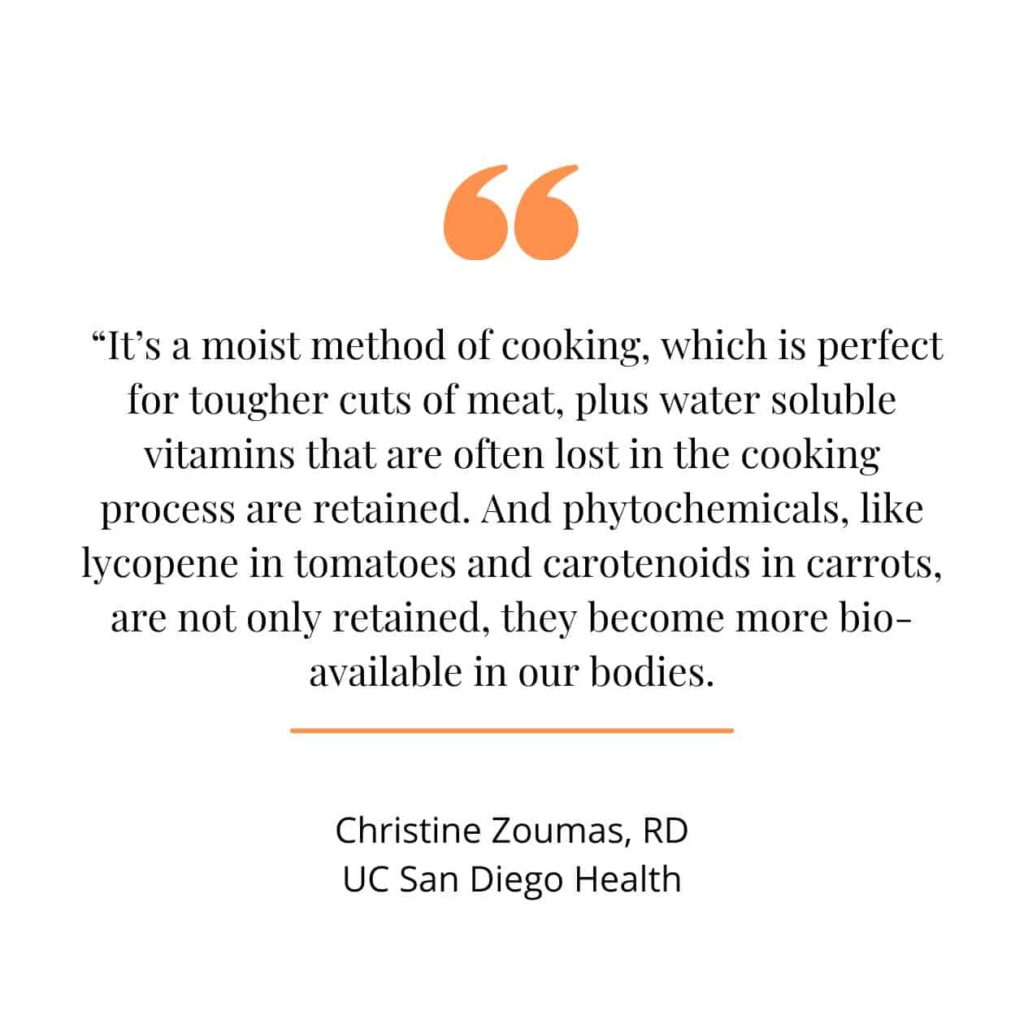
First of all, let’s take a look at the difference between stock and broth. You may think that these two terms can be used interchangeably. Indeed, they both have to do with that tasty, savory liquid that is made from meat, connective tissues, vegetables, and spices which can be used for everything from a hearty soup to a base for a remoulade (a type of sauce). Many people do use these terms interchangeably, although there is a difference. Even though the difference may seem small, it is significant.
The Gentle Broth
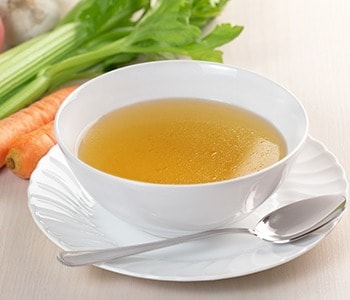
The main difference between stock and broth has to do with timing. A broth is basically any kind of liquid that has meat and/or vegetables cooked into it. For example, chicken broth or beef broth.
And here is a little-known side note about vegetable broth: when vegetables are used to make a broth, they are usually sautéed with butter or oil on low heat first to create what is called a mirepoix before they go in the pot [1].
In addition, a broth can be made in a relatively short amount of time. It is usually seasoned and will not turn gelatinous when it cools. And, yes, broth can be bought at the store, but if you do that, be sure to get organic and preferably low sodium for the healthiest choice.
Drinking broth can be soothing for the tummy and is often the go-to choice when you just want to “get something down” if you have the flu. Add some garlic and ginger to your broth and you have a real tonic for digestion and the common cold.
The Hearty Stock
Stock, on the other hand, is normally made from meat, and it is usually cooked for two to six hours. It often includes vegetables (or mirepoix) and most of the time includes the bones (e.g., beef bones or chicken bones) as well. Because stock isn’t left to boil for more than a few hours, as with broth it normally doesn’t turn gelatinous.
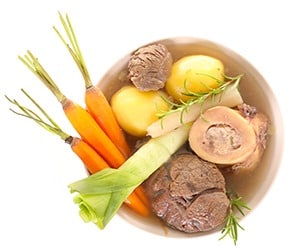
Seasoned cooks make stock specifically as a base for soups, for tasty stews, and for savory gravies and sauces. Often chefs will roast bones first on a baking sheet before they go in the stock to give the liquid a darker color and to give gravies a heartier flavor.
One more note about stock. Even though its nutrient value doesn’t come close to bone broth (which we will talk about in the next section), stock has been shown in some studies to be a highly nutritious immune-system booster in its own right.
Is Chicken Soup Actually a “Cure” for the Common Cold?
Researchers at the University of Nebraska wanted to test the validity of good old chicken soup, which usually simmers in the pot for two to six hours, for “curing the common cold.” What they found was pretty remarkable.
It turns out that generations of folkloric wisdom was right. Chicken soup actually contains several substances that help the immune system, including cells called neutrophils that act as strong anti-inflammatories in the body [2].
The Difference Between Broth and Bone Broth
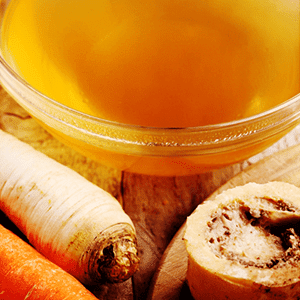
And finally, there is bone broth, which can be made just like stock, but has to be kept at a slow boil for a much longer period of time – often more than 24 hours. (Go here for more on how to make bone broth at home.)
As we mentioned above, stock and broth are often used as a delicious, healthy base for other recipes. Bone broth can be used that way as well but is most often sipped solo specifically for its gut-healing, collagen-building, and nutrient-dense effects.
In fact, one 2017 investigation published in the Journal of Renal Nutrition compared chicken soup made with bone broth to chicken soup made with regular broth. They found that one cup of bone broth chicken soup contains significantly more protein and other nutrients than regular chicken soup [3].
Vitamins & Minerals in Bone Broth
Bone broth has other nutritional advantages as well when compared to plain broth or even stock [4]. For starters, it is chock full of high amounts of essential vitamins and minerals, including:
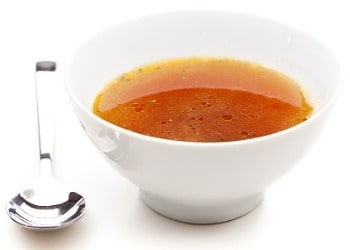
- vitamin K
- vitamin A
- iron
- selenium
- magnesium
- manganese
- potassium
- zinc
- essential fatty acids
Collagen (in the form of gelatin) and essential amino acids glycine and proline round out the unique combination of substances that make bone broth a nutritional powerhouse [5].
Because the bones boil for so long, the collagen inside the bones is released into the bone broth and turns to gelatin when bone broth is cooled. Want to know if your bone broth is going to pack a real nutritious punch? Let it cool. If it looks like “meat Jell-O” below the layer of fat on top, it’s a winner.
The amino acids in collagen/gelatin, in particular, make bone broth a healing elixir – especially for those with “Leaky Gut” and autoimmune conditions like arthritis.
What’s the Difference Between Collagen and Gelatin?
“Gelatin supplementation can increase exercise-induced collagen synthesis in humans.”
University of California, Davis
By the way, gelatin and collagen are basically the same substance. When it’s in the body it’s called “collagen” but it’s referred to as “gelatin” when it’s outside the body.
Bone Broth for Joint Health

A recent meta-analysis sponsored in part by researchers at the University of California, Davis, and published in the journal Sports Medicine found that supplementing with gelatin such as that found in bone broth can increase collagen levels in tissues and ease joint strain [6].
Another study published in Nutrition Journal discovered that type 2 collagen found in chicken bone broth can improve knee joint stiffness as well as ease pain and other discomforts associated with osteoarthritis [7].
Organic Bone Broth Is the Only Way to Go
Finally, if you’re going to make bone broth for health, you simply have to ensure it comes from bones of animals fed organic feed versus conventional animal feed.
While this is important for all kinds of broths and stocks, it’s especially relevant for bone broth. This is because while the marrow inside the bones is where the majority of the nutrients come from, it’s also where harmful toxins reside in commercial meats.
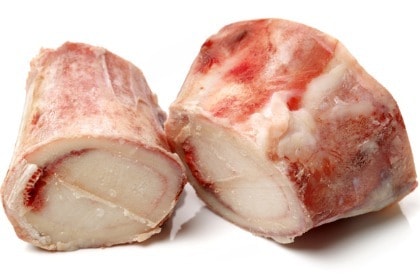
Many conventional animal feeds are sprayed with an herbicide known as Roundup, which is manufactured by Monsanto. The primary ingredient in Roundup is glyphosate. In a 2019 court case against Monsanto by a couple who were both diagnosed with lymphoma (cancer), evidence was presented showing that glyphosate ends up in the bones [8].
It’s only logical then that consuming bones and bone broth from animals that have consumed feed sprayed with glyphosate is not in the best interest of one’s health. As explained by GMO expert Jeffrey M. Smith in an interview with Organixx [9]:
“If you’re doing bone broth and you’re taking bones from animals that have been fed largely Roundup Ready soy or corn or canola meal or cotton meal or alfalfa – these are the 6 main GMOs. All of them are basically Roundup Ready … So there’s a tremendous amount of Roundup going into the animal. Moving into the bone. Now you take those bones and then you boil it and it ends up in the water as it’s water-soluble and then you put it into a capsule. This is not something you want to do.”
Jeffrey M. Smith, GMO Expert
Organixx Bone Broth powder is USDA Certified Organic and is GMO-free. It’s also free from major allergens such as gluten, dairy, corn, yeast, starch, and other grain products.
Organixx Clean Sourced Collagens blend contains five types of collagen from four sources. What’s more, it’s combined with targeted nutrients such as zinc, vitamin C, and vitamin B6 which specifically enhance the bioavailability and potency of collagen. Clean Sourced Collagens is formulated from the ground up to enhance and support your body’s natural ability to heal and rebuild itself from the INSIDE out.

 Sources:
Sources:
Article Summary
While many people use the terms “stock” and “broth” interchangeably, there is a difference – mostly to do with timing.
A broth is basically any kind of liquid that has meat and/or vegetables cooked into it. A broth can be made in a relatively short amount of time.
Stock is normally made from meat, and it is usually cooked for 2-6 hours. It often includes vegetables and most of the time includes the bones.
Bone broth can be made just like stock but has to be kept at a slow boil for a much longer period of time.
Bone broth has nutritional advantages when compared to plain broth or even stock. It is chock full of high amounts of essential vitamins and mineral and contains collagen (in the form of gelatin) and essential amino acids.
If you’re consuming bone broth, ensure the animals themselves were fed non-GMO feed that wasn’t sprayed with glyphosate as this common herbicide ends up in bones.
Organixx Bone Broth Protein powder is USDA certified organic and is an easy and safe alternative to making bone broth at home.


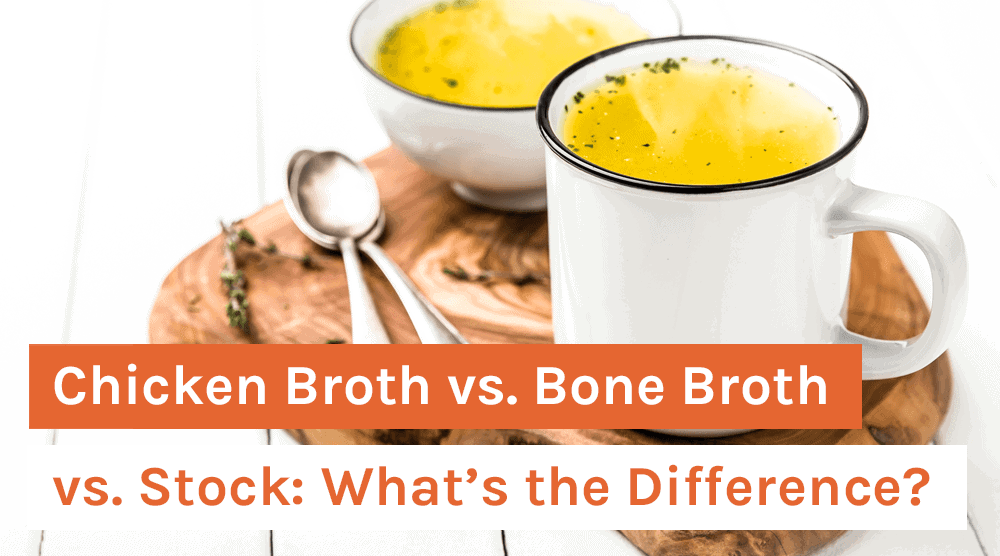


I'm upset! Here I saved all my chicken necks after my meat bird harvest thinking I was going to make HEALTHY bone broth. I usually feed organic but the corporations have raised the prices so much on organic feed I couldn't afford to pay $38 to $48 dollars a bag of feed when I was going through a bag a week.
Hi
if advertising and selling a product I do think that you should know if the chickens are free range. it makes me wonder!
Hi Sharon, thank you for your feedback.
The chickens used in our Bone Broth Protein contain no added antibiotics or hormones. However, we unable to guarantee they are free-range.
In addition, our chicken is from non-GMO Chicken bone broth. While we are not involved in the feeding and care of the chickens, the bone broth we use is tested for all heavy metal, pesticide, herbicide, antibiotics, molds, e-Coli and other environmental toxins.
Also, our Organic Bone Broth Protein is USDA-Certified Organic. Which means the chickens were fed organic feed, free from animal byproducts, antibiotics or genetically engineered grains.
If you would like to learn more about our Organic Bone Broth Protein, we invite to check out the following links:
Bone Broth Protein Info Page: https://organixx.com/bone-broth-protein/
Product label: http://organixx.com/wp-content/uploads/BoneBrothPlain-Organic-label-min.png
We hope this helps. Wishing you all the best!!
Wow! Until reading this article, I hadn't truly understood the importance of buying organically fed meat and poultry! Roundup seems to penetrate into much of our food supply, what a shame.
Thank you for the informative article
Much appreciated!
You're absolutely welcome Stacey! It is the mission of Organixx to support you in being the healthiest you possible. Whether it’s through our educational articles on our blog or from using our extremely clean and effective supplements, we're here to help you achieve your health goals.
Thank you for your feedback and we wish you a lovely day ahead!
how do you actually know if the sources in which you get your bones, in order to make the broth, have not been contaminated with this glyphosate? I have read (for example) that if land has an abundance of lead in the soil, the cattle, just by standing in it, can absorb the lead through the hooves and eventually get into the bones and in turn make the bone broth full of lead. Why wouldn't this hold true with soil that has been saturated with glyphosate?
Unless you buy organic meat you can assume it is in there.
Hi Linda, thank you for your question.
Our very own Organic Bone Broth Protein only uses chicken and no beef. The chickens used in our Bone Broth Protein contain no added antibiotics or hormones. However, we cannot guarantee they are free-range. To add, our chicken is from non-GMO chicken bone broth. While we are not involved in the feeding and care of the chickens, the bone broth we use is tested for all heavy metal, pesticide, herbicide, antibiotics, molds, e-Coli and other environmental toxins. Also, Organic Bone Broth Protein is USDA-Certified Organic. That means the chickens were fed organic feed, free from animal byproducts, antibiotics or genetically engineered grains.
You may take a look at the following pages for more information:
Product Specifications- https://organixx.com/bone-broth-protein/
Ingredient Label- http://organixx.com/wp-content/uploads/BoneBrothPlain-Organic-label-min.png
We hope you found them interesting and informative. If you have more questions for us, we'd be happy to answer them for you.
Have a great day ahead!
Awesome information
Hi Elisa,
Thank you for the positive feedback. We're glad you enjoyed the article.
We appreciate you being here with us. Hope you have a great day!!